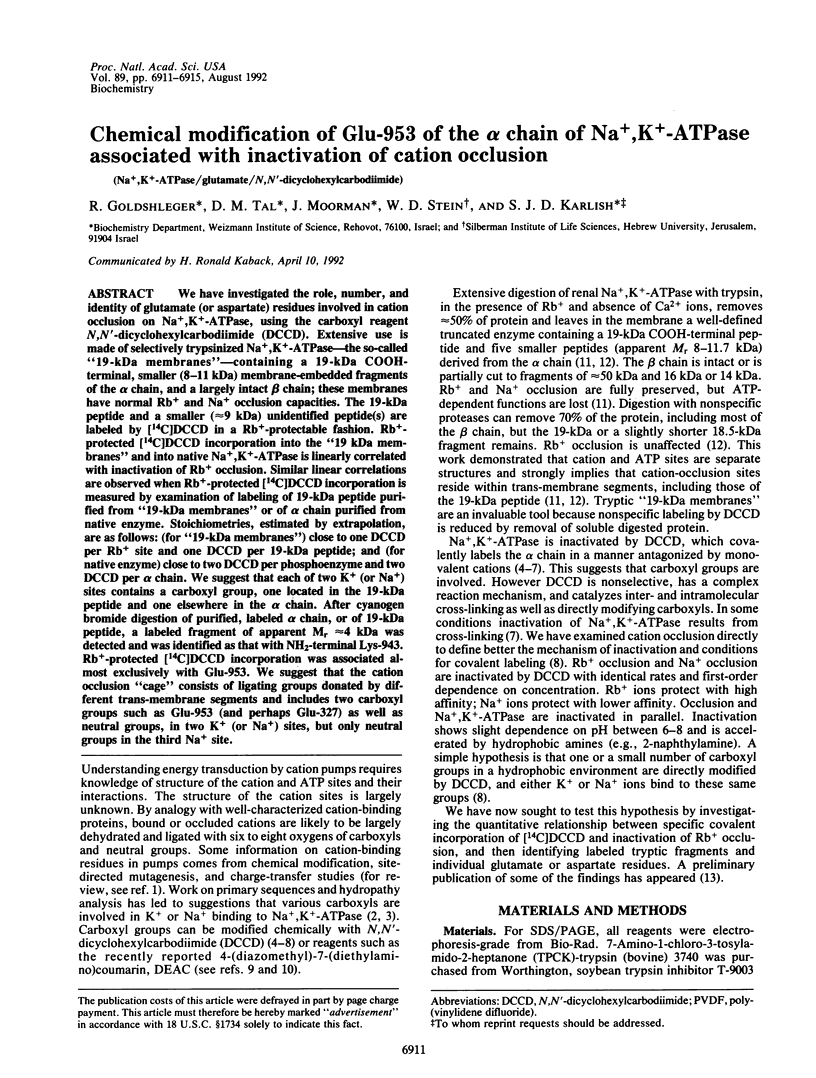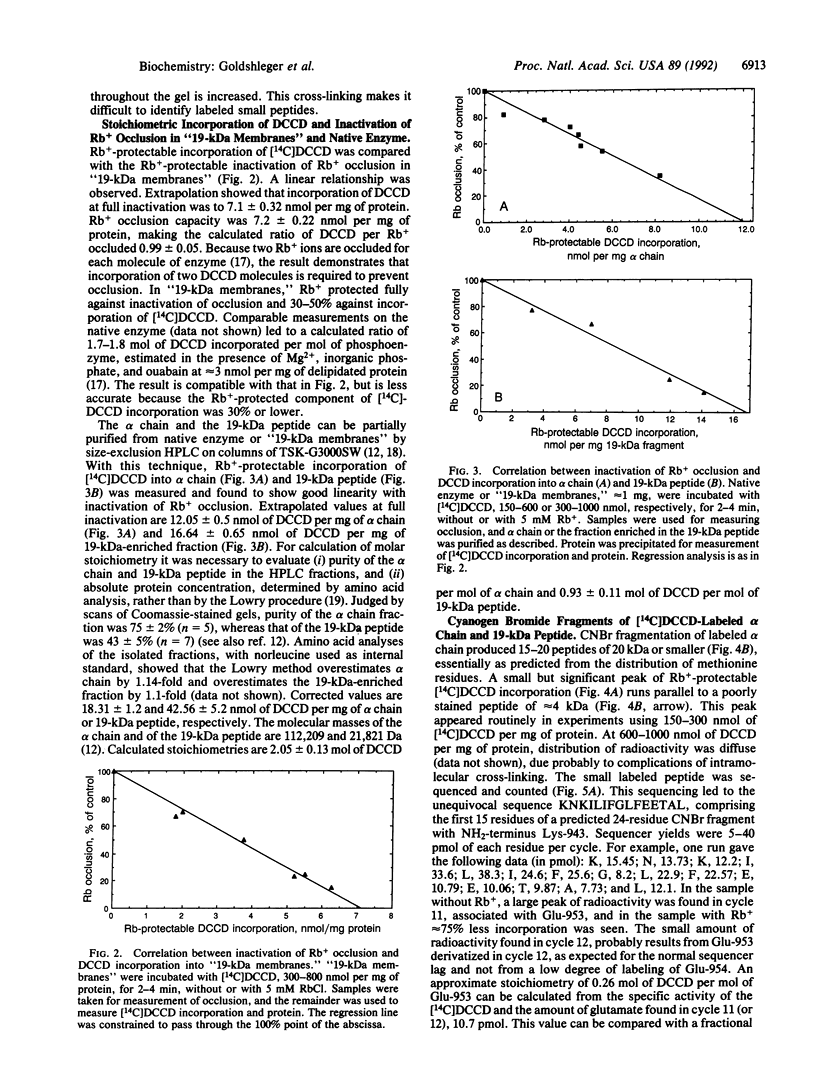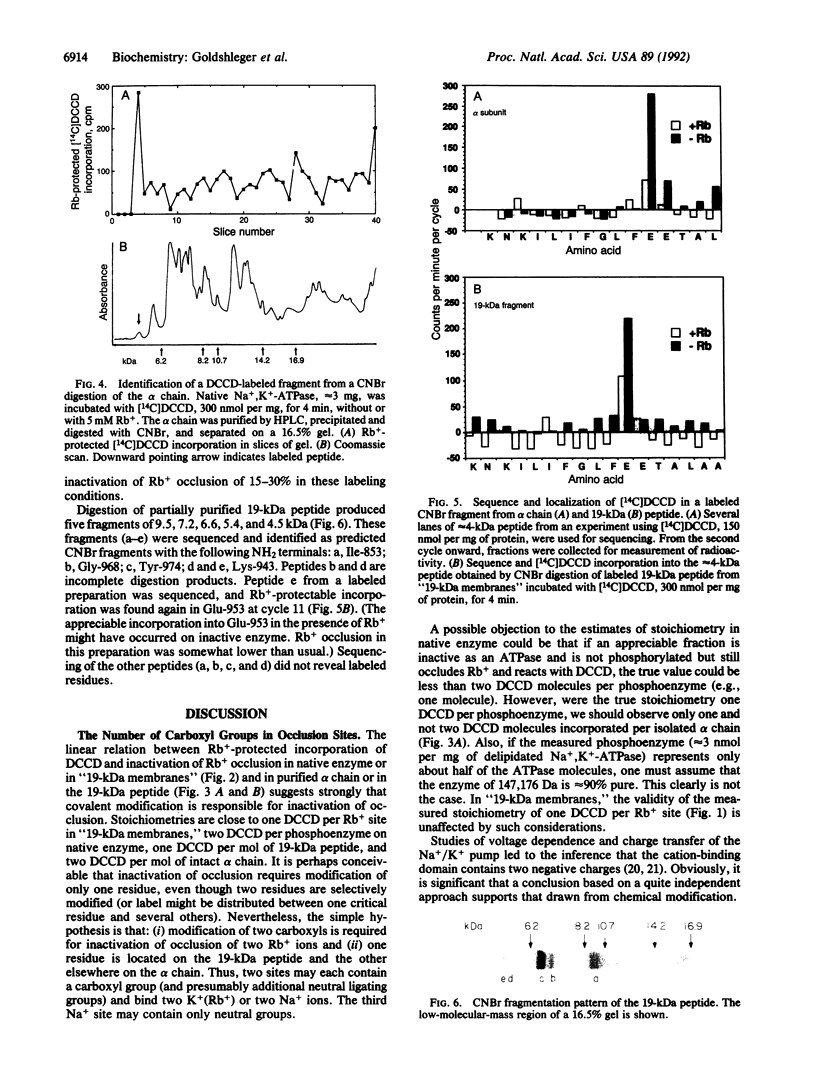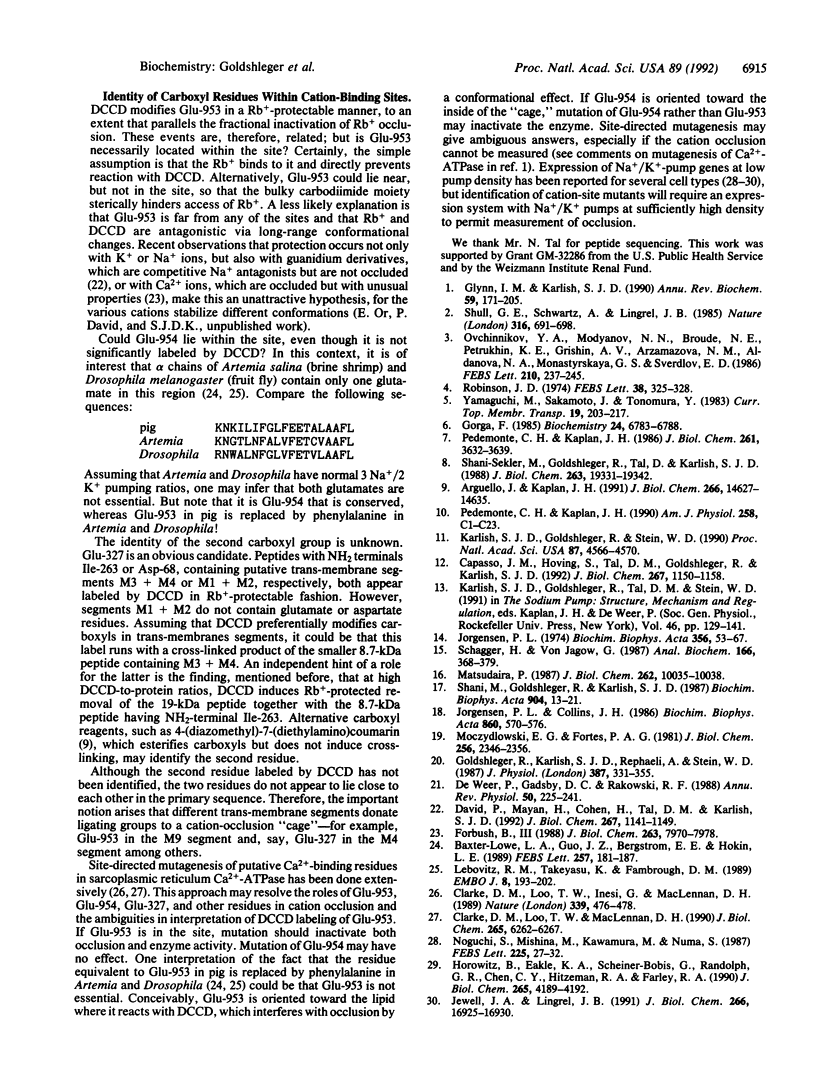Abstract
We have investigated the role, number, and identity of glutamate (or aspartate) residues involved in cation occlusion on Na+, K(+)-ATPase, using the carboxyl reagent N,N'-dicyclohexylcarbodiimide (DCCD). Extensive use is made of selectively trypsinized Na+,K(+)-ATPase--the so-called "19-kDa membranes"--containing a 19-kDa COOH-terminal, smaller (8-11 kDa) membrane-embedded fragments of the alpha chain, and a largely intact beta chain; these membranes have normal Rb+ and Na+ occlusion capacities. The 19-kDa peptide and a smaller (approximately 9 kDa) unidentified peptide(s) are labeled by [14C]DCCD in a Rb(+)-protectable fashion. Rb(+)-protected [14C]DCCD incorporation into the "19 kDa membranes" and into native Na+,K(+)-ATPase is linearly correlated with inactivation of Rb+ occlusion. Similar linear correlations are observed when Rb(+)-protected [14C]DCCD incorporation is measured by examination of labeling of 19-kDa peptide purified from "19-kDa membranes" or of alpha chain purified from native enzyme. Stoichiometries, estimated by extrapolation, are as follows: (for "19-kDa membranes") close to one DCCD per Rb+ site and one DCCD per 19-kDa peptide; and (for native enzyme) close to two DCCD per phosphoenzyme and two DCCD per alpha chain. We suggest that each of two K+ (or Na+) sites contains a carboxyl group, one located in the 19-kDa peptide and one elsewhere in the alpha chain. After cyanogen bromide digestion of purified, labeled alpha chain, or of 19-kDa peptide, a labeled fragment of apparent M(r) approximately 4 kDa was detected and was identified as that with NH2-terminal Lys-943. Rb(+)-protected [14C]DCCD incorporation was associated almost exclusively with Glu-953. We suggest that the cation occlusion "cage" consists of ligating groups donated by different trans-membrane segments and includes two carboxyl groups such as Glu-953 (and perhaps Glu-327) as well as neutral groups, in two K+ (or Na+) sites, but only neutral groups in the third Na+ site.
Full text
PDF




Images in this article
Selected References
These references are in PubMed. This may not be the complete list of references from this article.
- Arguello J. M., Kaplan J. H. Evidence for essential carboxyls in the cation-binding domain of the Na,K-ATPase. J Biol Chem. 1991 Aug 5;266(22):14627–14635. [PubMed] [Google Scholar]
- Baxter-Lowe L. A., Guo J. Z., Bergstrom E. E., Hokin L. E. Molecular cloning of the Na,K-ATPase alpha-subunit in developing brine shrimp and sequence comparison with higher organisms. FEBS Lett. 1989 Oct 23;257(1):181–187. doi: 10.1016/0014-5793(89)81816-2. [DOI] [PubMed] [Google Scholar]
- Capasso J. M., Hoving S., Tal D. M., Goldshleger R., Karlish S. J. Extensive digestion of Na+,K(+)-ATPase by specific and nonspecific proteases with preservation of cation occlusion sites. J Biol Chem. 1992 Jan 15;267(2):1150–1158. [PubMed] [Google Scholar]
- Clarke D. M., Loo T. W., Inesi G., MacLennan D. H. Location of high affinity Ca2+-binding sites within the predicted transmembrane domain of the sarcoplasmic reticulum Ca2+-ATPase. Nature. 1989 Jun 8;339(6224):476–478. doi: 10.1038/339476a0. [DOI] [PubMed] [Google Scholar]
- Clarke D. M., Loo T. W., MacLennan D. H. Functional consequences of alterations to polar amino acids located in the transmembrane domain of the Ca2(+)-ATPase of sarcoplasmic reticulum. J Biol Chem. 1990 Apr 15;265(11):6262–6267. [PubMed] [Google Scholar]
- David P., Mayan H., Cohen H., Tal D. M., Karlish S. J. Guanidinium derivatives act as high affinity antagonists of Na+ ions in occlusion sites of Na+,K(+)-ATPase. J Biol Chem. 1992 Jan 15;267(2):1141–1149. [PubMed] [Google Scholar]
- De Weer P., Gadsby D. C., Rakowski R. F. Voltage dependence of the Na-K pump. Annu Rev Physiol. 1988;50:225–241. doi: 10.1146/annurev.ph.50.030188.001301. [DOI] [PubMed] [Google Scholar]
- Forbush B., 3rd Rapid release of 45Ca from an occluded state of the Na,K-pump. J Biol Chem. 1988 Jun 15;263(17):7970–7978. [PubMed] [Google Scholar]
- Glynn I. M., Karlish S. J. Occluded cations in active transport. Annu Rev Biochem. 1990;59:171–205. doi: 10.1146/annurev.bi.59.070190.001131. [DOI] [PubMed] [Google Scholar]
- Goldshlegger R., Karlish S. J., Rephaeli A., Stein W. D. The effect of membrane potential on the mammalian sodium-potassium pump reconstituted into phospholipid vesicles. J Physiol. 1987 Jun;387:331–355. doi: 10.1113/jphysiol.1987.sp016576. [DOI] [PMC free article] [PubMed] [Google Scholar]
- Gorga F. R. Inhibition of (Na+,K+)-ATPase by dicyclohexylcarbodiimide. Evidence for two carboxyl groups that are essential for enzymatic activity. Biochemistry. 1985 Nov 19;24(24):6783–6788. doi: 10.1021/bi00345a009. [DOI] [PubMed] [Google Scholar]
- Horowitz B., Eakle K. A., Scheiner-Bobis G., Randolph G. R., Chen C. Y., Hitzeman R. A., Farley R. A. Synthesis and assembly of functional mammalian Na,K-ATPase in yeast. J Biol Chem. 1990 Mar 15;265(8):4189–4192. [PubMed] [Google Scholar]
- Jewell E. A., Lingrel J. B. Comparison of the substrate dependence properties of the rat Na,K-ATPase alpha 1, alpha 2, and alpha 3 isoforms expressed in HeLa cells. J Biol Chem. 1991 Sep 5;266(25):16925–16930. [PubMed] [Google Scholar]
- Jorgensen P. L. Purification and characterization of (Na+ plus K+ )-ATPase. IV. Estimation of the purity and of the molecular weight and polypeptide content per enzyme unit in preparations from the outer medulla of rabbit kidney. Biochim Biophys Acta. 1974 Jul 12;356(1):53–67. doi: 10.1016/0005-2736(74)90293-4. [DOI] [PubMed] [Google Scholar]
- Jørgensen P. L., Collins J. H. Tryptic and chymotryptic cleavage sites in sequence of alpha-subunit of (Na+ + K+)-ATPase from outer medulla of mammalian kidney. Biochim Biophys Acta. 1986 Sep 11;860(3):570–576. doi: 10.1016/0005-2736(86)90555-9. [DOI] [PubMed] [Google Scholar]
- Karlish S. J., Goldshleger R., Stein W. D. A 19-kDa C-terminal tryptic fragment of the alpha chain of Na/K-ATPase is essential for occlusion and transport of cations. Proc Natl Acad Sci U S A. 1990 Jun;87(12):4566–4570. doi: 10.1073/pnas.87.12.4566. [DOI] [PMC free article] [PubMed] [Google Scholar]
- Karlish S. J., Goldshleger R., Tal D. M., Stein W. D. Structure of the cation binding sites of Na/K-ATPase. Soc Gen Physiol Ser. 1991;46:129–141. [PubMed] [Google Scholar]
- Lebovitz R. M., Takeyasu K., Fambrough D. M. Molecular characterization and expression of the (Na+ + K+)-ATPase alpha-subunit in Drosophila melanogaster. EMBO J. 1989 Jan;8(1):193–202. doi: 10.1002/j.1460-2075.1989.tb03364.x. [DOI] [PMC free article] [PubMed] [Google Scholar]
- Matsudaira P. Sequence from picomole quantities of proteins electroblotted onto polyvinylidene difluoride membranes. J Biol Chem. 1987 Jul 25;262(21):10035–10038. [PubMed] [Google Scholar]
- Moczydlowski E. G., Fortes P. A. Characterization of 2',3'-O-(2,4,6-trinitrocyclohexadienylidine)adenosine 5'-triphosphate as a fluorescent probe of the ATP site of sodium and potassium transport adenosine triphosphatase. Determination of nucleotide binding stoichiometry and ion-induced changes in affinity for ATP. J Biol Chem. 1981 Mar 10;256(5):2346–2356. [PubMed] [Google Scholar]
- Noguchi S., Mishina M., Kawamura M., Numa S. Expression of functional (Na+ + K+)-ATPase from cloned cDNAs. FEBS Lett. 1987 Dec 10;225(1-2):27–32. doi: 10.1016/0014-5793(87)81125-0. [DOI] [PubMed] [Google Scholar]
- Ovchinnikov YuA, Modyanov N. N., Broude N. E., Petrukhin K. E., Grishin A. V., Arzamazova N. M., Aldanova N. A., Monastyrskaya G. S., Sverdlov E. D. Pig kidney Na+,K+-ATPase. Primary structure and spatial organization. FEBS Lett. 1986 Jun 9;201(2):237–245. doi: 10.1016/0014-5793(86)80616-0. [DOI] [PubMed] [Google Scholar]
- Pedemonte C. H., Kaplan J. H. Carbodiimide inactivation of Na,K-ATPase. A consequence of internal cross-linking and not carboxyl group modification. J Biol Chem. 1986 Mar 15;261(8):3632–3639. [PubMed] [Google Scholar]
- Pedemonte C. H., Kaplan J. H. Chemical modification as an approach to elucidation of sodium pump structure-function relations. Am J Physiol. 1990 Jan;258(1 Pt 1):C1–23. doi: 10.1152/ajpcell.1990.258.1.C1. [DOI] [PubMed] [Google Scholar]
- Robinson J. D. Affinity of the (Na+ plus K+)-dependent ATPase for Na+ measured by Na+-modified enzyme inactivation. FEBS Lett. 1974 Jan 15;38(3):325–328. doi: 10.1016/0014-5793(74)80083-9. [DOI] [PubMed] [Google Scholar]
- Schägger H., von Jagow G. Tricine-sodium dodecyl sulfate-polyacrylamide gel electrophoresis for the separation of proteins in the range from 1 to 100 kDa. Anal Biochem. 1987 Nov 1;166(2):368–379. doi: 10.1016/0003-2697(87)90587-2. [DOI] [PubMed] [Google Scholar]
- Shani-Sekler M., Goldshleger R., Tal D. M., Karlish S. J. Inactivation of Rb+ and Na+ occlusion on (Na+,K+)-ATPase by modification of carboxyl groups. J Biol Chem. 1988 Dec 25;263(36):19331–19341. [PubMed] [Google Scholar]
- Shani M., Goldschleger R., Karlish S. J. Rb+ occlusion in renal (Na+ + K+)-ATPase characterized with a simple manual assay. Biochim Biophys Acta. 1987 Nov 2;904(1):13–21. doi: 10.1016/0005-2736(87)90081-2. [DOI] [PubMed] [Google Scholar]
- Shull G. E., Schwartz A., Lingrel J. B. Amino-acid sequence of the catalytic subunit of the (Na+ + K+)ATPase deduced from a complementary DNA. Nature. 1985 Aug 22;316(6030):691–695. doi: 10.1038/316691a0. [DOI] [PubMed] [Google Scholar]



